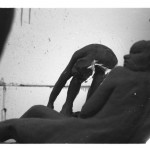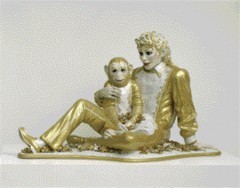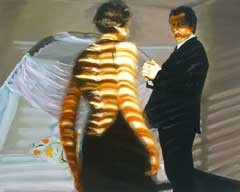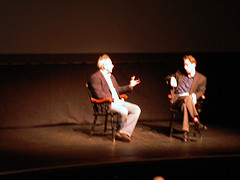
Eric Fischl speaking at Penn. Fischl is left and Alexi Wolfe, who introduced him and here is asking some questions, is right.
As Dan mentions in his post about Eric Fischl, two — not just one — big, bad-boy New York artists came to Penn last week to speak about their work. Mostly the talks by Jeff Koons (see Libby’s post) and Eric Fischl were spin by mid-career artists who are now writing themselves (or attempting to) into the history books the way they want to be seen.

Jeff Koons, Michael Jackson and Bubbles
Based on the chronological slide show of his sculpture and recent paintings, Koons inadvertently demonstrated that the energy has gone out of his works. Early pieces were and still are interesting, edgy, funny and sociologically-reverberant. In my book, the gilded porcelain statue of Michael Jackson and Bubbles (1988) is Koons at his best.
The most recent works are an embarrassment — multi-layered and chaotic-looking paintings. The artist knew they were weak because he kept describing what was in them — you truly couldn’t make it out because of the jumble.
The most interesting thing the artist had to say was, paraphrasing, “Don’t drop the ball when it’s passed to you,” meaning, if you want fame, fortune and glory, seize it, and don’t defer or put off what may turn out to be a golden opportunity. Amen.
As for Fischl, the slides he showed were, with one exception, not his own works. Fischl was making the case for figurative art — and for the figure in art. Why he thought he needed to do that at a time of great renewed interest in figuration became clear near the end when he put up the one slide of his own work, the Tumbling Woman statue he made commemorating the victims of 9-11. This statue, which the artist made as an elegy to the victims, appeared in a corporate lobby in New York and was quickly removed because people objected (it was too graphic, it raised too many horrible memories, it was dark and ugly and too big, etc). I think Fischl may be smarting from that rejection and his slide lecture was a way of dealing.
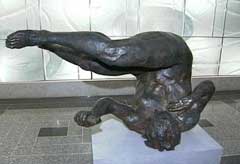
Eric Fischl, Tumbling Woman.
The whole talk was a rumination and heartfelt at that. It was bitter and angry and poignant especially in its ending.
Here is how the artist ended. He was making a case that art used to be the mediator between the audience and what could not be seen:
Maybe art is inferior to the needs of the culture. My final point, and it’s probably way too histrionic, is that removing the body from the experience means we can’t empathize. Therefore we can tolerate Abu Ghraib. It’s amazing when you think of art — even modernist art — was allied with politics (eg feminism, etc) and there wasn’t so much that was big going on.
Then we get to a point when something really big happens (9-11, and Abu Ghraib — and now we’re a country that tortures people) and we’re mute (i.e., art is mute).
Did I bum you guys out? Anyway, I’m going to stop there because I don’t know what to do with it….
Libby and I have always known that you must write your own history. We do it all the time in our art. It was most interesting to see that we small potatoes artists are on the same page with these big bad old boys for once in our lives.



